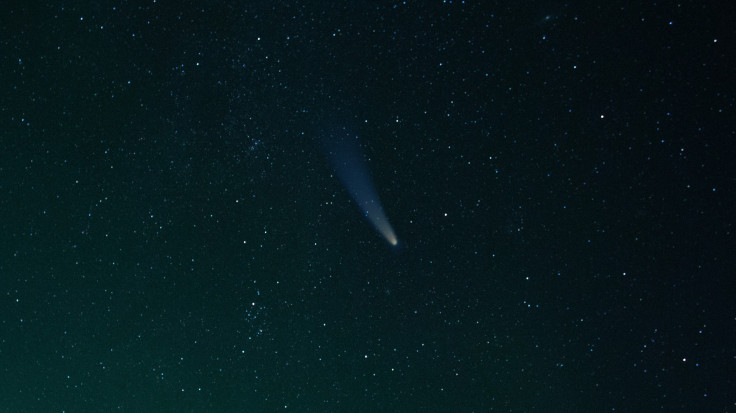3I/ATLAS Mystery: Name Is 'Only Straightforward Detail' Scientists Can Agree On
3I/ATLAS: The only thing scientists agree on is the name. Is it a comet or a probe?

It is not often that the silent void of deep space delivers a visitor to our doorstep. Usually, the comets and asteroids we track are local residents, ancient debris bound to our Sun by gravity's invisible tether. But occasionally, something breaks the rules.
Since July, a mysterious traveller has been racing through our cosmic neighbourhood, sparking a blend of scientific excitement and existential curiosity. It is fast, it is unusual, and it is heading for a close encounter with Earth this December.
This is not just another rock; it is the centre of a global riddle that has astronomers and billionaires alike looking to the skies. Amidst the chaos of conflicting theories—ranging from a 'dark comet' to an alien probe—there remains only one detail that hasn't sparked a shouting match: its name. While the designation '3I/ATLAS' is a triumph of bureaucratic clarity, everything else about this object is a masterclass in cosmic confusion.

The Fierce Debate Over the True Nature of 3I/ATLAS
The arrival of this object has done more than just alert the sensors; it has divided the scientific community and captured the imagination of the world's most powerful figures. Detected in July by the NASA-funded ATLAS observatory, the object quickly became a subject of intense scrutiny.
While traditionalists and some researchers described it as a comet, the conversation took a sharp turn when Harvard theoretical physicist Avi Loeb suggested it could be an alien 'mothership' on a reconnaissance mission.
The speculation reached the tech world, with SpaceX founder Elon Musk acknowledging that 'it could be alien' and warning that any deviation from its expected trajectory could pose a real risk as it sweeps past Earth on December 19. In a recent appearance on The Joe Rogan Experience, Musk added fuel to the fire with his trademark blend of humour and dark prophecy.
Discussing the object's unusually high nickel composition, he joked, 'I'm never committing suicide, to be clear. So, on camera, I am never committing suicide ever!'—a tongue-in-cheek nod to conspiracy theories suggesting those who uncover alien truths are often silenced.
On a more serious note, he admitted that if the object were indeed an artificial nickel construct, 'it would be a very sort of heavy spaceship... it would like, obliterate a continent.' Taking the situation seriously, the European Space Agency has already mobilised teams to monitor its path, using telescopes in Hawaii, Chile and Australia.
Decoding the Designation: How 3I/ATLAS Got Its Name
As questions circulated about its origins, many people also wondered why the visitor carries the unusual tag 3I/ATLAS. According to NASA's designation system, the structure of the name is deliberate and tells a specific story about the object's history. The letter 'I' identifies it as an interstellar object, meaning it is not gravitationally bound to our star. The number '3' marks it as only the third confirmed interstellar visitor ever observed in human history.
Finally, 'Atlas' refers to the survey program that first spotted it, the Asteroid Terrestrial-impact Last Alert System. This updated naming system was introduced because modern surveys detect far more comets and interstellar objects than in the past, making traditional naming conventions impractical.
It serves as a catalogue entry for a new era of astronomy where our sensors are powerful enough to catch these fleeting visitors. Ironically, this dry, alphanumeric label is currently the only 'straightforward detail' scientists can agree on. While the name perfectly follows protocol, the object itself refuses to do the same.
3I/ATLAS Joins the Exclusive Club of Interstellar Visitors
To understand the significance of 3I/ATLAS, one must look at its predecessors. Before 3I/ATLAS appeared, only two other interstellar bodies had been recorded. The first was 1I/ʻOumuamua in 2017, famous for its cigar shape and erratic motion. The second was 2I/Borisov in 2019, identified as a more conventional comet. Now, 3I/ATLAS joins this exclusive club.
Despite the alarmist theories regarding its trajectory, NASA says 3I/ATLAS poses no threat to Earth and will come no closer than 170 million miles. It has already completed a significant flyby, having passed within 19 million miles of Mars in early October and recently performed a slingshot around the sun.
During a press conference on November 19, NASA officials attempted to quell the alien hype, stating firmly that the object 'behaves like a comet' and citing its coma and tail as proof of natural origins. However, critics were quick to point out that the agency's released images were underwhelming 'fuzzy blobs' that failed to address the more specific anomalies raised by independent researchers.

Unusual Features and the Future of 3I/ATLAS
The story is far from over. Astronomers are now combing through older images in a process known as precovery to trace its path deeper into the past. Despite months of study, experts remain divided over the object's true nature. Observations have shown unusual features, including what some describe as an 'anti-tail', a formation where dust appears to point toward the sun instead of away from it.
But the oddities do not stop there. Avi Loeb has identified a '13th anomaly' that he claims defies standard physics: two thin, ruler-straight jets extending roughly one million kilometres from the object. Unlike natural cometary jets, which wobble due to rotation, these lines remain perfectly straight, forming an uncanny 'X' shape.
Furthermore, Loeb calculated that a tiny, non-gravitational push the object received while hidden behind the Sun has precisely adjusted its course to target Jupiter. The object is now on track to pass exactly 53.4 million kilometres from the gas giant in March 2026—matching Jupiter's 'Hill radius' (the edge of its gravitational influence) within a razor-thin margin.
Loeb calls this an 'extraordinary coincidence' that could allow a mothership to deploy probes into Jupiter's orbit.
As NASA, ESA and independent researchers will continue tracking the visitor as it clears the inner Solar System in the coming weeks, the world watches to see if 3I/ATLAS is merely a dusty iceberg, or something far more profound.
While the bureaucratic label '3I/ATLAS' is settled, the true nature of this interstellar traveller remains a tantalising open question. As it departs Earth's vicinity to keep its statistically improbable date with Jupiter in 2026, the line between astrophysical data and science fiction has never been blurrier.
Whether a natural oddity or a manufactured marvel, 3I/ATLAS has successfully turned the entire solar system into a stage for the ultimate cosmic debate.
© Copyright IBTimes 2025. All rights reserved.




















